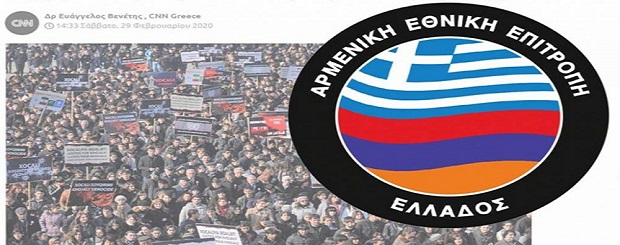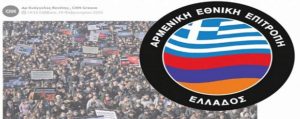
ARF – ARMENIAN NATIONAL COMMITTEE OF GREECE response to CNN Greece’s misleading article
March 3, 2020, Society.

On a popular website, CNN Greece, on February 28, an article signed by Evangelos Venetis appeared as an expert on Middle East and Caucasus issues.
The article talks about the events in Khojaly and attributes them to the Armenians, reporting that the Armenians committed the massacre of innocent Azeri residents.
A joke that we have been accustomed to hear from the Azeri side, but this time it is a signature by an “expert” that tries to appear “factual”, even hinting at publications from Western world newspapers, which are also known as Azeri propaganda past.
ARF was immediate The Armenian National Committee of Greece’s reaction to the CNN Greece article, which responded in a letter to the website, detailing historical facts and Azeri provocations and misinformation.
azator.gr:
Letter to CNN. Greece
Athens 29/2/2020
In response to the article
by Dr. Evangelos Veneti,
on the massacre in Hojali
It is not the first time that an attempt has been made to mislead the Greek public about alleged “slaughter of Azeri civilians by Armenians” in the town of Hodgali in Mountainous Karabagh in February 1992.
We are sorry to see this kind of misinformation being published by the reputable CNN.Greece news agency, which has not accustomed us to invalid and thorough publications.
In full respect of your reading audience, we consider it necessary to provide some information, with the sole purpose of properly informing the public and restoring the truth.
The government of Azerbaijan is engaged in an ever-increasing tactic of defaming Armenians and misinforming public opinion by spreading false and false information. The case of the Hojali tragedy is typical. The real events are distorted and distorted to turn the perpetrators into victims! It was Azerbaijan that planned and executed the organized massacres of Armenians in Sumgait, Girovabat and Baku, as well as mass displacements of the Armenian populations, in response to the inalienable right of the inhabitants of Karabagh.
The people of Karabagh, throughout the 70 years of Azeri rule, have been subjected to all forms of oppression and have never ceased to seek its administrative independence from Azerbaijan and its reunification with Armenia.
In February 1988, by exercising his constitutionally guaranteed right, by mass peaceful demonstrations and by a unanimous resolution of the local parliament, he claimed his right to self-determination. Within a few days, the Azeri authorities had responded, following the standards of their Turkish brothers … A savage attack and massacre of Armenian residents for three consecutive days in Sumkait, just 20 km from Baku’s capital … The Armenians were killed in Sumgait an example of ethnic violence in the modern history of the USSR and played a decisive role in the outbreak of war in Karabagh and the collapse of the USSR. A few months later, new massacres of civilians, violence and displacement of Armenians in Kirovabat, Baku and other cities followed.
At a heavy price for blood, the Armenians of Karabagh gradually succeeded in pushing out their opponents and liberating villages and towns. Determined was the security of Stepanagert, the capital of Karabagh, which the Azeris bombarded relentlessly with heavy machine guns and rockets, using the Hojali village as a base, turning it automatically into a military target. Hodgaly had to be apprehended for the additional reason that it was blocking access to the only airport – connecting Karabagh with the outside world for humanitarian aid.
Caring for the safe evacuation of the civilian population used by the Azeri army as a shield in early January 1992, the Karabagh authorities informed the Azeri side of the forthcoming military operations. They warned civilians via radio, television, leaflets, etc. that a safe exit – a runway to the city of Akdam, held by the Azeris, north of Hojali – would be available. Indeed, for two weeks before the start of the operation, the Mountainous Self-Defense Forces observed a mass exodus of civilians through the runway.
The operation to neutralize the Hojali military base began at 11pm on 25 February and was completed successfully in five hours. The rescue forces of Karabagh found 11 corpses of civilians in Hodgaly and its outskirts outside the military enclave. Around 700 people, civilians and soldiers, surrendered to the Karabagh Self-Defense Forces.
As hostilities unfolded in Hodgali, a large group of civilians and armed Azeris, using the humanitarian corridor, moved towards the Azeri-controlled Akdam. Strangely enough, however, and while in a region completely controlled by the Azeris, they were fired from the Azeri side, many of them losing their lives.
According to third-party and Azeri officials, including the then President of Azerbaijan Ayaz Mutalibov, the incident was attributed to the opposition forces. As part of the internal power struggle, they sought to blame for what happened to him, which led to his overthrow.
An orchestrated effort was later launched to lay claim to responsibility for the deaths of civilians on the Armenian side. Indeed, over the years, the attempt to falsify and defame Armenians by the Azeris has been enriched with “photographic material”, such as photographs of victims of the devastating earthquake of ’83 in Turkey, of victims of the Hamas in Palestine, of the war in Kosovo. , or pogroms in the Balkans…
Witnesses to the events
Immediately after the events, Azeri journalist Tsinkiz Mustafayev arrives at the site, photographing and describing what he saw. Two days later he returns to find that some corpses had been deformed or abused and moved to appear to have fallen from an Armenian fire. Realizing that something suspicious is going on, he conducts his own investigation and speaks to the Moscow-based news agency DR-Press about the Azeri side’s responsibility for the events in Hodzhali. Killed a few days later, under uncertain conditions, near Agdam.
The same image of the carcasses is found by Czech journalist Jana Mazalova, who was in the area shortly after the operation and returned two days later.
Azeri human rights activist Aris Yunusov said: “The city and its inhabitants were deliberately sacrificed on the altar of political expediency” (Azeri newspaper “Zerkalo”, July 1992).
Tamerlane Karaev, then President of the Supreme Soviet of the Republic of Azerbaijan, said: “The tragedy was the work of the Azeri authorities and especially senior officials” (Mughalifat Azeri newspaper, April 28, 1992).
President Heydar Aliyev himself acknowledged that “the former Azerbaijani leadership is responsible” for the events in Hodgaly. However, in April 1992, according to the Bilik Dunjasi agency, he cynically stated: “We will exploit the bloodshed. We will not interfere in the development of the matter. ”
The aforementioned testimonies are only a few examples of the multitude of testimonies and evidence that the Azeris are responsible for the killings in Hodgali, and that they have committed a monstrous crime against their own people for political reasons. The Hoxali civilians have fallen victim to the dirty games of the Baku authorities, who are still trying to turn the tragedy into a political capital for exploitation and manipulation!
ARMENIAN NATIONAL COMMITTEE OF GREECE
ENGLISH TRANSLATION “lousavor avedis”
ENGLISH TRANSLATION “lousavor avedis“
